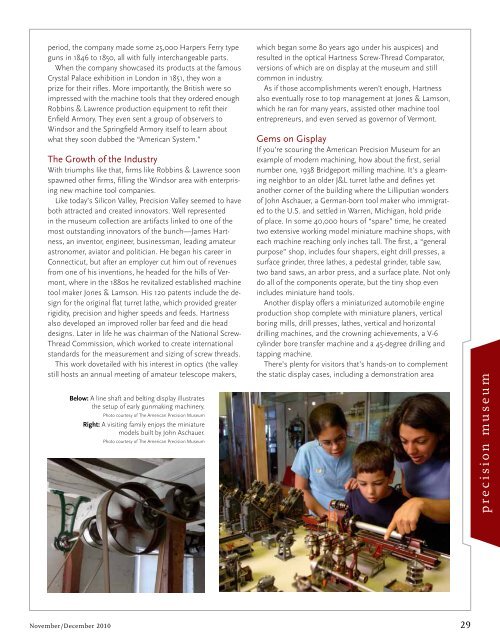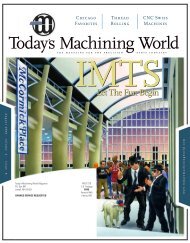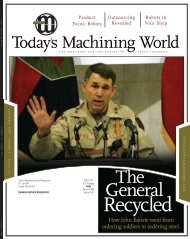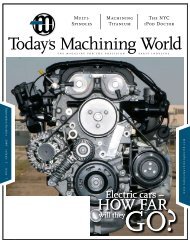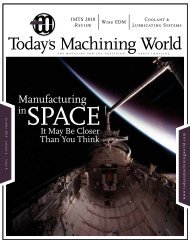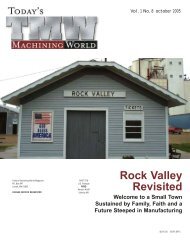A Night at the - Today's Machining World
A Night at the - Today's Machining World
A Night at the - Today's Machining World
You also want an ePaper? Increase the reach of your titles
YUMPU automatically turns print PDFs into web optimized ePapers that Google loves.
period, <strong>the</strong> company made some 25,000 Harpers Ferry type<br />
guns in 1846 to 1850, all with fully interchangeable parts.<br />
When <strong>the</strong> company showcased its products <strong>at</strong> <strong>the</strong> famous<br />
Crystal Palace exhibition in London in 1851, <strong>the</strong>y won a<br />
prize for <strong>the</strong>ir rifles. More importantly, <strong>the</strong> British were so<br />
impressed with <strong>the</strong> machine tools th<strong>at</strong> <strong>the</strong>y ordered enough<br />
Robbins & Lawrence production equipment to refit <strong>the</strong>ir<br />
Enfield Armory. They even sent a group of observers to<br />
Windsor and <strong>the</strong> Springfield Armory itself to learn about<br />
wh<strong>at</strong> <strong>the</strong>y soon dubbed <strong>the</strong> “American System.”<br />
The Growth of <strong>the</strong> Industry<br />
With triumphs like th<strong>at</strong>, firms like Robbins & Lawrence soon<br />
spawned o<strong>the</strong>r firms, filling <strong>the</strong> Windsor area with enterprising<br />
new machine tool companies.<br />
Like today’s Silicon Valley, Precision Valley seemed to have<br />
both <strong>at</strong>tracted and cre<strong>at</strong>ed innov<strong>at</strong>ors. Well represented<br />
in <strong>the</strong> museum collection are artifacts linked to one of <strong>the</strong><br />
most outstanding innov<strong>at</strong>ors of <strong>the</strong> bunch—James Hartness,<br />
an inventor, engineer, businessman, leading am<strong>at</strong>eur<br />
astronomer, avi<strong>at</strong>or and politician. He began his career in<br />
Connecticut, but after an employer cut him out of revenues<br />
from one of his inventions, he headed for <strong>the</strong> hills of Vermont,<br />
where in <strong>the</strong> 1880s he revitalized established machine<br />
tool maker Jones & Lamson. His 120 p<strong>at</strong>ents include <strong>the</strong> design<br />
for <strong>the</strong> original fl<strong>at</strong> turret l<strong>at</strong>he, which provided gre<strong>at</strong>er<br />
rigidity, precision and higher speeds and feeds. Hartness<br />
also developed an improved roller bar feed and die head<br />
designs. L<strong>at</strong>er in life he was chairman of <strong>the</strong> N<strong>at</strong>ional Screw-<br />
Thread Commission, which worked to cre<strong>at</strong>e intern<strong>at</strong>ional<br />
standards for <strong>the</strong> measurement and sizing of screw threads.<br />
This work dovetailed with his interest in optics (<strong>the</strong> valley<br />
still hosts an annual meeting of am<strong>at</strong>eur telescope makers,<br />
Below: A line shaft and belting display illustr<strong>at</strong>es<br />
<strong>the</strong> setup of early gunmaking machinery.<br />
Photo courtesy of The American Precision Museum<br />
Right: A visiting family enjoys <strong>the</strong> mini<strong>at</strong>ure<br />
models built by John Aschauer.<br />
Photo courtesy of The American Precision Museum<br />
which began some 80 years ago under his auspices) and<br />
resulted in <strong>the</strong> optical Hartness Screw-Thread Compar<strong>at</strong>or,<br />
versions of which are on display <strong>at</strong> <strong>the</strong> museum and still<br />
common in industry.<br />
As if those accomplishments weren’t enough, Hartness<br />
also eventually rose to top management <strong>at</strong> Jones & Lamson,<br />
which he ran for many years, assisted o<strong>the</strong>r machine tool<br />
entrepreneurs, and even served as governor of Vermont.<br />
Gems on Gisplay<br />
If you’re scouring <strong>the</strong> American Precision Museum for an<br />
example of modern machining, how about <strong>the</strong> first, serial<br />
number one, 1938 Bridgeport milling machine. It’s a gleaming<br />
neighbor to an older J&L turret l<strong>at</strong>he and defines yet<br />
ano<strong>the</strong>r corner of <strong>the</strong> building where <strong>the</strong> Lilliputian wonders<br />
of John Aschauer, a German-born tool maker who immigr<strong>at</strong>ed<br />
to <strong>the</strong> U.S. and settled in Warren, Michigan, hold pride<br />
of place. In some 40,000 hours of “spare” time, he cre<strong>at</strong>ed<br />
two extensive working model mini<strong>at</strong>ure machine shops, with<br />
each machine reaching only inches tall. The first, a “general<br />
purpose” shop, includes four shapers, eight drill presses, a<br />
surface grinder, three l<strong>at</strong>hes, a pedestal grinder, table saw,<br />
two band saws, an arbor press, and a surface pl<strong>at</strong>e. Not only<br />
do all of <strong>the</strong> components oper<strong>at</strong>e, but <strong>the</strong> tiny shop even<br />
includes mini<strong>at</strong>ure hand tools.<br />
Ano<strong>the</strong>r display offers a mini<strong>at</strong>urized automobile engine<br />
production shop complete with mini<strong>at</strong>ure planers, vertical<br />
boring mills, drill presses, l<strong>at</strong>hes, vertical and horizontal<br />
drilling machines, and <strong>the</strong> crowning achievements, a V-6<br />
cylinder bore transfer machine and a 45-degree drilling and<br />
tapping machine.<br />
There’s plenty for visitors th<strong>at</strong>’s hands-on to complement<br />
<strong>the</strong> st<strong>at</strong>ic display cases, including a demonstr<strong>at</strong>ion area<br />
November/December 2010 29<br />
precision museum


